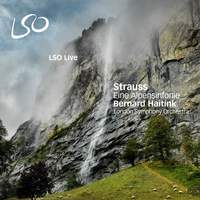Recording of the Week,
Strauss: Alpine Symphony
One of my favourite big orchestral works is the Alpine Symphony of Richard Strauss. It was his last symphonic poem, and written in 1915 was much later than the group that he had written in the late 1880s and 1890s with which he had established his reputation – including Don Juan (1888), Till Eulenspiegel (1895) and Also Sprach Zarathustra (1896). It is a massive work, about fifty minutes long and scored for about 125 musicians, and it is perhaps because of these proportions that it seems to be less frequently performed that it really deserves.

Strauss’s Alpine Symphony consists of twenty-two continuous sections of music, during which time the music depicts an attempt to conquer the summit of an Alpine mountain. Each section has a title so you know throughout what the music is depicting. For example it starts in the night, but soon the sun rises and the climbers begin their ascent. As they ‘enter the woods’ the textures thicken and the upper woodwinds sing like birds. Cascading scale figures in the strings and winds represent ‘the waterfall’, and on ‘the alpine pasture’ you hear the cowbells and even the bleating of sheep (depicted through a technique called flutter tonguing in the oboe and E-flat clarinet). There is a glacier and dangerous moments before they finally arrive ‘on the summit’ as the four trombones present the ‘peak motive’. On the way down the mountain the mists gather before a storm erupts with flashes of lightning (in the piccolo) and the use of a wind machine. They finally arrive at the bottom and as night falls the music returns to the way the whole piece had begun.
It is wonderfully evocative and Strauss apparently experienced an Alpine adventure similar to the one described in the music when he was a boy, when he and a group of climbers lost their way heading up a mountain and were caught in a storm and soaked on the way down.
The Alpine Symphony has a famous discography with many great recordings already in the catalogue, and in 1983 Karajan’s recording with the Berlin Philharmonic became the first compact disc ever to be pressed. As you can imagine a successful performance depends upon an outstanding orchestra able to depict the atmosphere of the climb as well as master the technical challenges. The conductor has to pace the work, control the orchestral palette and keep his head – making sure that the real climaxes arrive only when they’re supposed to rather than peaking too soon. The LSO under Bernard Haitink have just released a new recording made live at the Barbican in June 2008 and they’re well up to the task. The sound is wonderfully clear and spacious and by the end you really feel that you have been on a journey up and down a mountain.
I’ve given you the Thunderstorm to listen to which the climbers encounter on their descent. You sense more than anything the awe-inspiring force of nature and Strauss’s ability to depict that in his writing, as well as the LSO under Haitink on superb form, and an excellent recorded sound. Enjoy!
Available Formats: MP3, FLAC, Hi-Res FLAC



